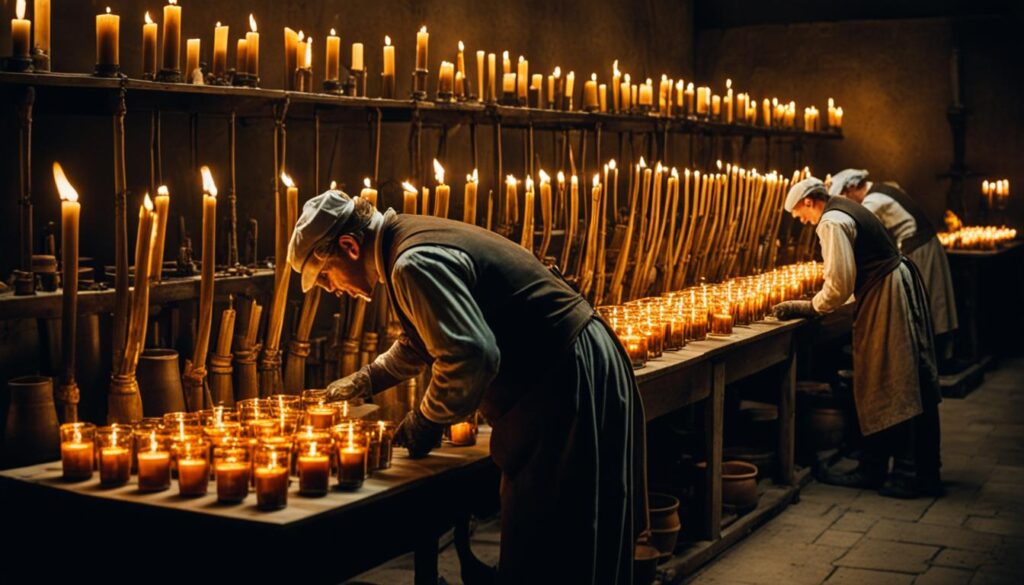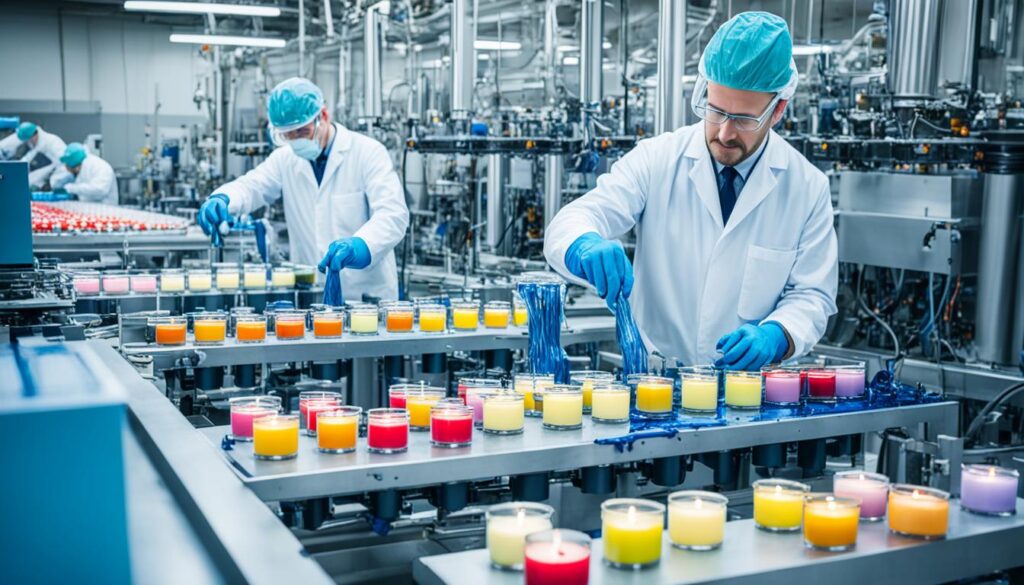The History and Evolution of Candle Making
Candles have lit the way for people for thousands of years. They’ve been key in many cultures. Ever wondered about their history and how they’ve changed? From ancient times to today, candle making is a story of creativity, tradition, and constant improvement. Join us as we dive into this fascinating craft.
Key Takeaways
- Candles have been used for over 5,000 years, with ancient civilizations like the Egyptians and Romans pioneering the early development of candle-making techniques.
- The evolution of candle making has been marked by the use of various materials, from animal fats to beeswax, spermaceti, and paraffin wax.
- Candles have played a significant role in religious ceremonies, celebrations, and everyday life throughout history.
- The candle industry has continuously adapted to technological advancements, leading to innovations in wax, wicks, and production methods.
- Today, candles are not only functional but also cherished as decorative items, with luxury brands like LAFCO leading the way in high-end candle making.
But what is the true origin of the candle, and how have these versatile light sources evolved over time? Prepare to embark on a captivating journey through the history and evolution of candle making, where the past and present converge to illuminate the future of this timeless craft.
The Origins of Candle Making
The history of candles goes way back, thousands of years. Ancient civilizations used early forms of candles. From Egypt’s sands to Asia’s lush lands, the story of candle making is quite interesting.
Ancient Civilizations’ Use of Candles
In ancient Egypt, around 3000 B.C., people made candles with wicks. They used animal fat, called tallow, and reed or papyrus for the wick.
In ancient China, candles were used too, around the same time. They made candles with wax from insects and seeds, and used rice paper for the wick. The Japanese used tree nuts for wax, and the Indians got their wax by boiling the cinnamon tree fruit.
Early Evidence of Wicked Candles
- Many early cultures, like the Mesopotamians, Greeks, and Romans, also made wicked candles. They used waxes from plants and insects.
- These candles were not just for lighting. They were important in religious and cultural events, symbolizing light, purity, and spirituality.
- The fact that these candles were found in many cultures shows how much people wanted light. It also shows how candles have always been a source of light and warmth.
Candle making’s history shows how our ancestors were creative and adaptable. They found ways to light up their world with early candles.
The Emergence of Candle Making in Europe
The art of candle making spread across Europe as the Western world grew. Early on, people used tallow candles made from animal fat. But, the Middle Ages brought a big change with beeswax candles.
Tallow and Beeswax Candles
Tallow candles were made from animal fat and lit most homes. But beeswax candles became a better choice. They burned cleaner and didn’t smoke as much, making them a more efficient light source.
Candlemaking Guilds and Chandlers
By the 13th century, candle making had its own guilds in France and England. These candlemaking guilds controlled candle production and sales. Chandlers, or candle makers, made candles right in customers’ homes using kitchen fats and waxes.
| Candle Type | Characteristics |
|---|---|
| Tallow Candles | Made from animal fat, produced a smoky flame |
| Beeswax Candles | Burned cleaner and more efficiently, a superior alternative |
The rise of candle making guilds and professional chandlers was a big step. It helped make tallow candles and beeswax candles a big part of European life. This move helped the candle-making industry grow even more.
Candle Making in Colonial America
In colonial America, people added their own chapter to candle making’s history. Early American women found a clever way to make candles from bayberry bush berries. These berries are grayish-green and full of wax.
Getting wax from the bayberries was hard work, but the candles burned well and smelled nice. Yet, these candles didn’t stay popular because making them was too hard.
Even so, the colonial era saw a big growth in colonial candle making. People kept finding new ways to make candles, using things like tallow and beeswax. This made American candle history rich and diverse.
As the colonies got bigger and stronger, candle making grew too. “Chandlers,” skilled candle makers, shared their knowledge with others. They formed guilds to keep the candle making quality high and fair.
The colonial era’s impact on candle making shows our long history of innovation and resilience. This spirit has always been part of the American story.
Innovations in the 18th and 19th Centuries
The 18th century brought big changes to candle making. Spermaceti, a wax from sperm whale oil, was a key innovation. It made spermaceti candles popular for their bright flame and clean burn.
In the 1820s, French chemist Michel Eugene Chevreul made a big leap forward. He found a way to make stearic wax from animal fats. This wax was hard, long-lasting, and burned well.
Mechanized Candle Production
The 19th century changed candle making with a new machine. In 1834, British engineer Joseph Morgan invented a machine that made making candles faster and better. This led to more candles being made, making them cheaper and more available.
These new ideas in making spermaceti candles and using machines changed the candle industry. They made candles a common item in homes around the world.

“The whaling industry of the 18th century heralded in the first significant change in candle making since the Middle Ages.”
The Decline and Revival of Candle Making
The history of candle making is full of ups and downs. The light bulb’s invention in 1879 marked a big change. It started to make candles less needed for lighting. But, the candle’s story didn’t end there.
In the early 1900s, candle making saw a big comeback. The U.S. oil and meatpacking industries grew, making paraffin and stearic acid more common. These ingredients made candles cheaper and more accessible, sparking renewed interest.
Until the mid-1980s, candles were still popular. Then, people started seeing them as more than just light sources. They became decorations, mood-setters, and gifts. This new view made candle making popular again, with many new styles and scents.
“Candles have the power to transform a space, creating a warm, inviting atmosphere that can soothe the senses and lift the spirit.”
Now, the candle industry keeps changing with new materials and designs. From old wick-and-tallow candles to modern soy-based ones, candle making shows how adaptable and resilient it is. It reflects our ongoing need for light and how we want to make our spaces special.
The history of candle making
The Introduction of Paraffin Wax
In the 1850s, candle making changed with the introduction of paraffin wax. This wax comes from petroleum and changed the game. It was a clean-burning, consistent, and cheaper option than traditional candles.
Paraffin wax became popular for its lack of smell and white color. It burned better than before, giving a brighter flame and longer candle life. This made paraffin wax a big deal in the history of candle wax. It led to making more candles and making them easier to get.
The use of paraffin wax changed candle making and the industry. Making candles got cheaper and they got better quality. This made candles more affordable and available to more people.
| Characteristic | Paraffin Wax | Traditional Waxes |
|---|---|---|
| Odor | Odorless | Distinct odors |
| Color | Bluish-white | Varying hues |
| Burn Quality | Clean, consistent | Irregular, sooty |
| Cost Efficiency | Economical | More expensive |
The arrival of paraffin wax was a big step in the history of candle wax. It helped make candle making better and more efficient. This change still helps the candle industry today.
The Modern Candle Industry
The modern candle industry has changed a lot. What started as simple lighting has turned into something more. Now, candles are seen as decorative items, mood-setters, and gifts. Soy wax candles are leading this change, becoming very popular.
Candles as Decorative Items
Candles are now key to home decor. They add warmth and elegance to any room. People can pick from many shapes, sizes, colors, and scents to match their style.
Whether you like modern or rustic designs, there’s a candle for you. The decorative candles market offers something for everyone.
The Development of Soy Wax
In the 1990s, soy wax became a big deal in the candle world. Scientists wanted a greener option and found it in soybeans. Soy wax is eco-friendly and doesn’t have harsh chemicals.
Soy wax candles also burn cleaner than others. They don’t make much soot and are better for the air we breathe.
“The modern candle industry has transformed candles from mere functional objects to captivating decorative elements that set the mood and enhance our living spaces.”
The modern candle industry keeps growing. Soy wax and decorative candles are in demand for their sustainability and beauty.

LAFCO: Luxury Candle Making
LAFCO is a leader in luxury home fragrance since 1992. They follow a European tradition of using botanicals. They make sustainable home fragrance solutions that delight the senses.
The LAFCO House & Home Collection
The House & Home Collection is LAFCO’s highlight. It was launched in 2007. These luxury candles come in beautiful, handcrafted glass and use premium soy wax and 100% cotton wicks.
LAFCO’s commitment to sustainability and luxury is clear in their candles. They use soy wax for a cleaner, longer burn. This means a consistent, beautiful fragrance in your home.
“LAFCO candles are more than just a home accessory – they’re a work of art that beautifully elevates the ambiance of any room.”
Looking to make your space cozy or elegant? The LAFCO House & Home Collection has many enticing scents. Each one is made with great care, making LAFCO a top name in luxury candles.
Conclusion
The story of candle making is full of innovation and the lasting charm of these simple lights. From ancient times, when people used tallow and beeswax, to today’s artisans making soy candles, it shows human creativity. This history is a testament to our ability to adapt and innovate.
Throughout the centuries, candle making has changed from a basic need to a symbol of celebration and home decor. You might prefer the classic look of a LAFCO candle or the eco-friendly choice of a soy candle. Either way, the craft of candle making still inspires and fascinates us.
The candle industry keeps changing, but one thing stays the same: the magic of these lights. They have lit our way and sparked our imaginations for many years. So, when you light your next candle, think about the long history behind it. Let its warmth and light inspire you to make your own lasting memories.
FAQ
What is the history of candle making?
How did candle making evolve over time?
What were some of the innovations in candle making?
How have candles been used throughout history?
What is the story behind LAFCO and their luxury candles?
Source Links
- https://en.wikipedia.org/wiki/History_of_candle_making – History of candle making
- https://candles.org/history/ – History – National Candle Association
- https://blog.lafco.com/history-of-candle-making/ – The History of Candle Making: From Ancient Civilizations to Modern Day – LAFCO New York
- Fragrance That Wows: A Beginner’s Guide to Adding Scents to Your Homemade Candles
- best essential oils for candles
- wood wick guide
- how to make candles smell stronger
- how to ship candles
- how to fix soy wax frosting
- wick Guide how to choose the right wick size with chart
- how to make candle molds
- how to clean candle wax
- how to reuse candle jars
- soy wax candle troubleshooting
- best wax melter for candle making
- how to conduct burn test
- why candle flickering crackling smoking
- how much wax per candle
- how to make candles smell stronger
- Easy Ways to Increase the Scent Throw of Your DIY Candles
- How to Make Candles for Meditation and Relaxation
- Using Upcycled Materials in Candle Making
- How to Make Hand-Poured Candles: Tips and Techniques

Leave a Reply